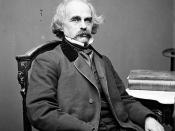Nathaniel Hawthorne's The Scarlet Letter is one of the most analyzed and most discussed literary works in American literature and for good reason. Hawthorne's ambiguity and his intense use of symbols have made this work incredibly complex and incredibly bothersome. In The Scarlet Letter, Nathaniel Hawthorne uses many symbols to give insight into characters and promote his views on society. The scaffold scenes in The Scarlet Letter tell the reader exactly what is to come, and the presence of light in those scenes gives the reader insight into the characters.
The scaffold scenes establish a pattern of what is to come in the novel through a common tie prevalent in the three different scaffold scenes. The tie is that of creation and release. In the first scaffold scene, Hester releases not only her guilt about her crime, but, she also releases Pearl to the society and creates in Pearl the need for strength and determination that she will need to overcome the legacy of her creation.
In this scene she also creates the need in Dimmesdale to absolve himself of his guilt. The second scaffold scene is the opportunity for Dimmesdale to attempt to release his guilt from the first scaffold. However, Pearl creates a need in Dimmesdale to repent in front of the town. During the third scaffold scene, Dimmesdale is able to release his guilt about his crime and his lack of strength. He is also able to complete his obligation to accept the hands of Pearl and Hester on the platform from the second scaffold scene. Through his confession, he creates a sense of reality for the entire town. It can be clearly seen that what is created in the first scaffold is released in the second scaffold; while, the things created in the second scaffold are...


